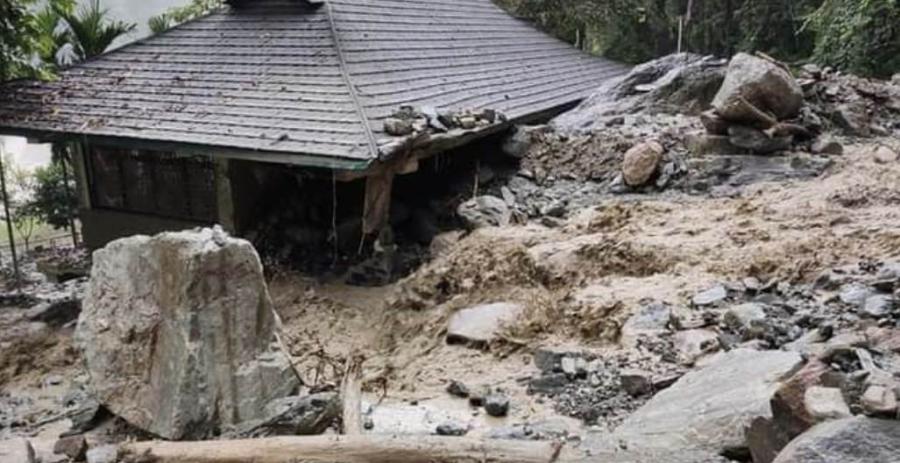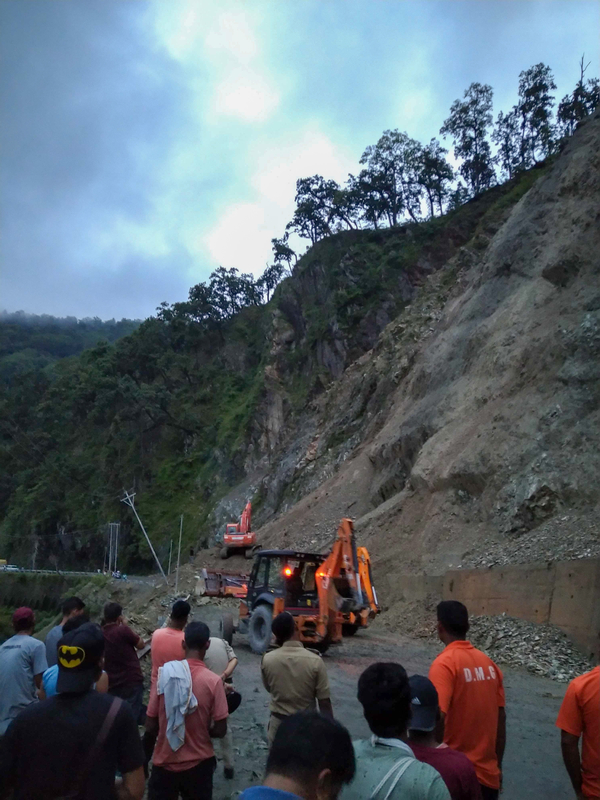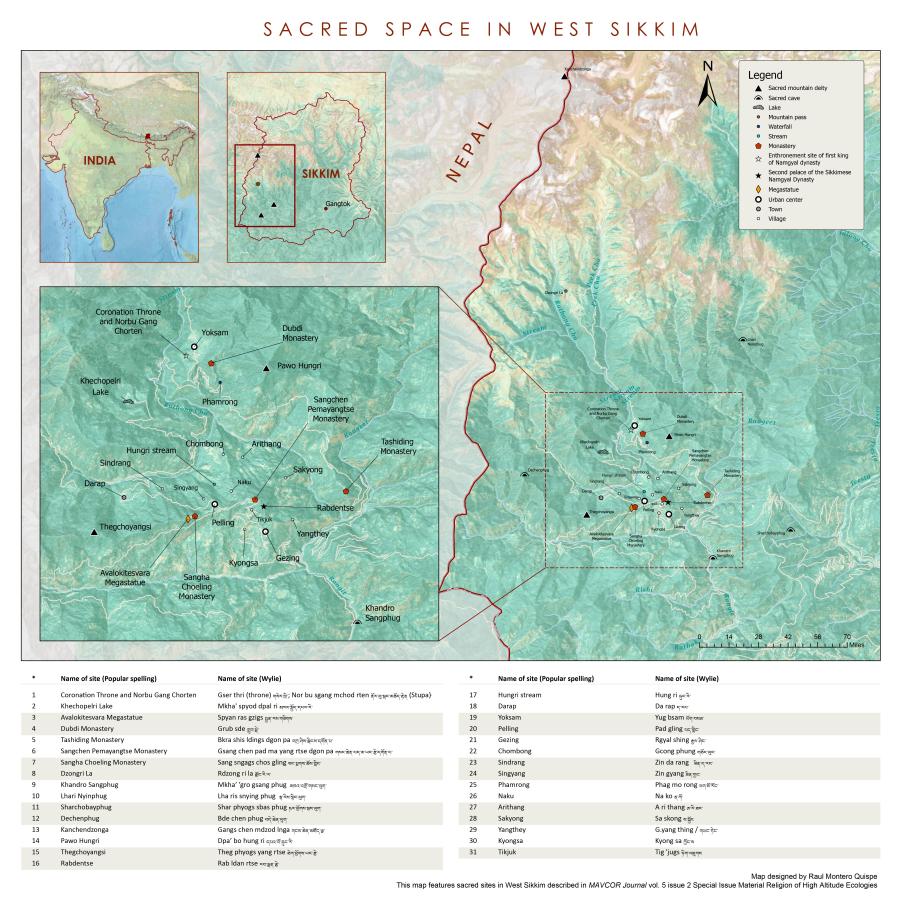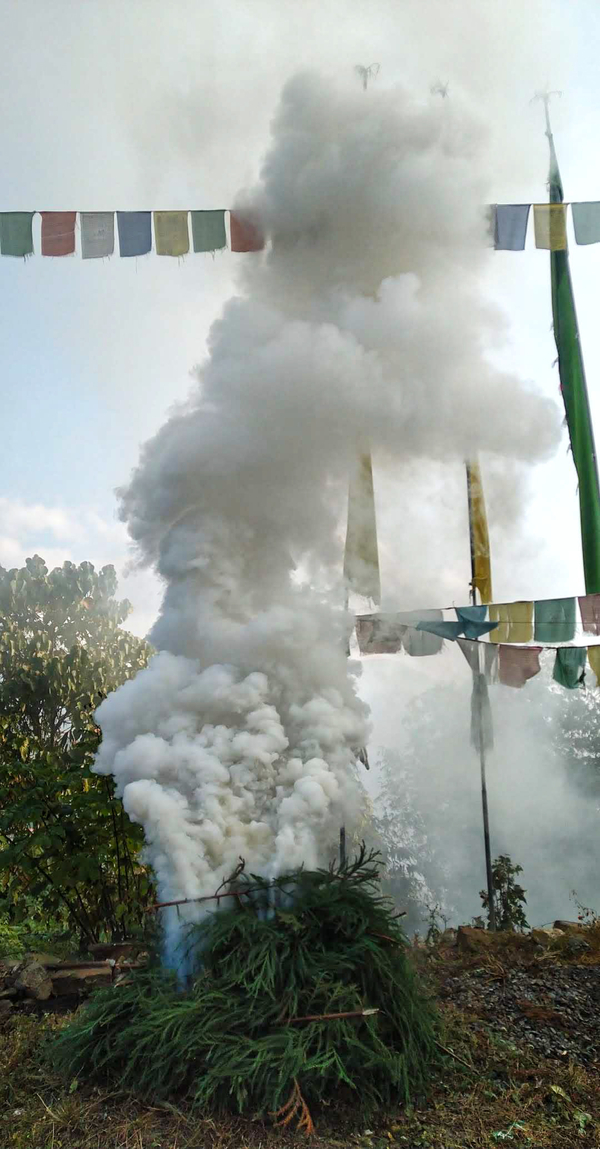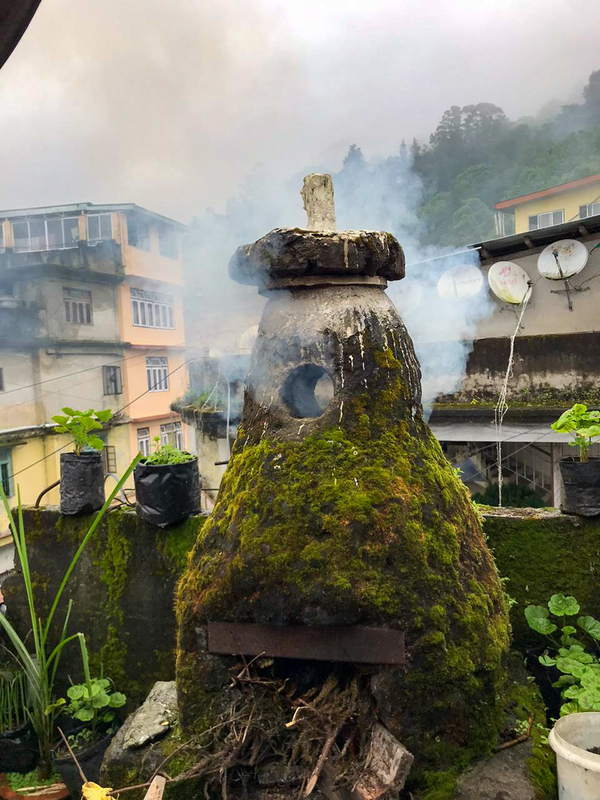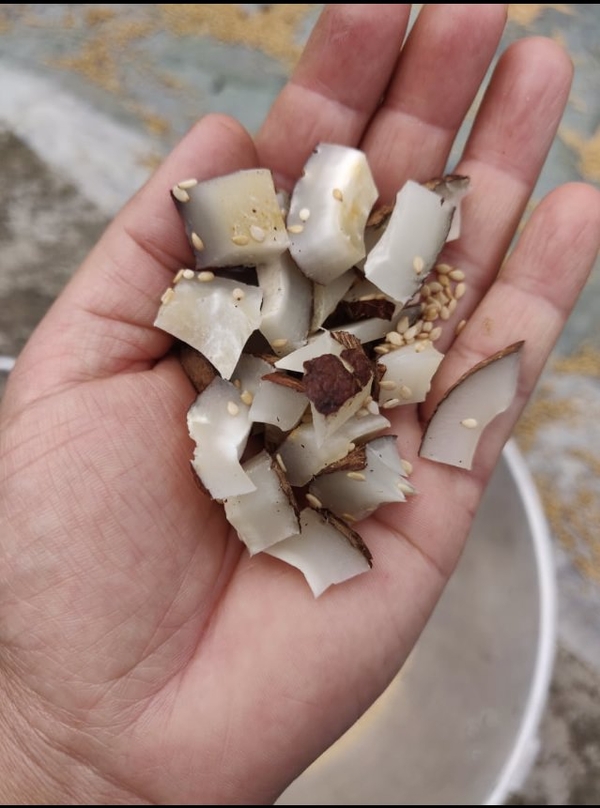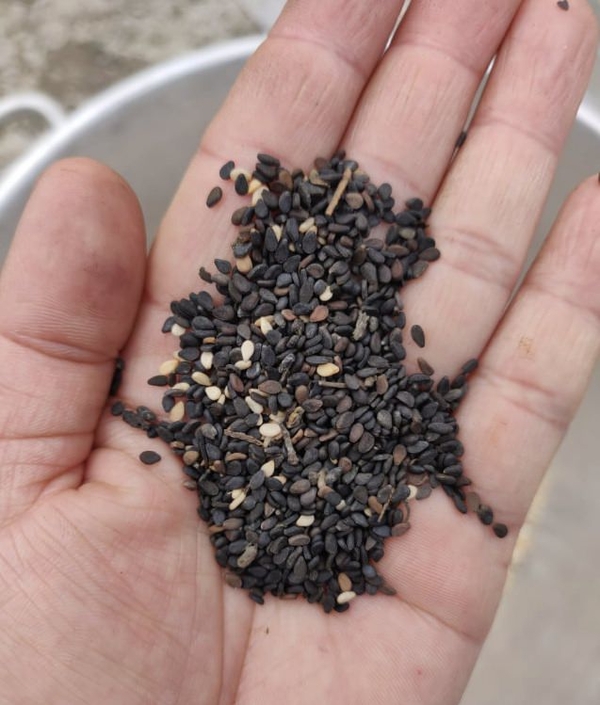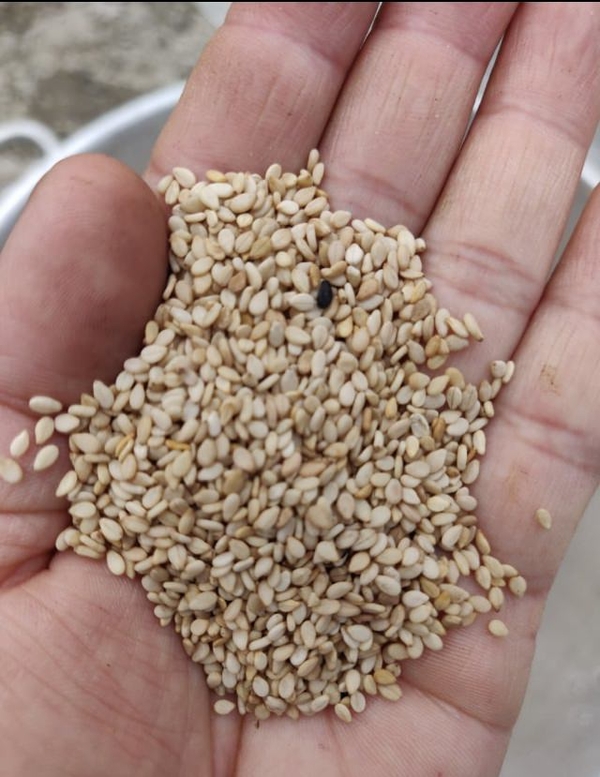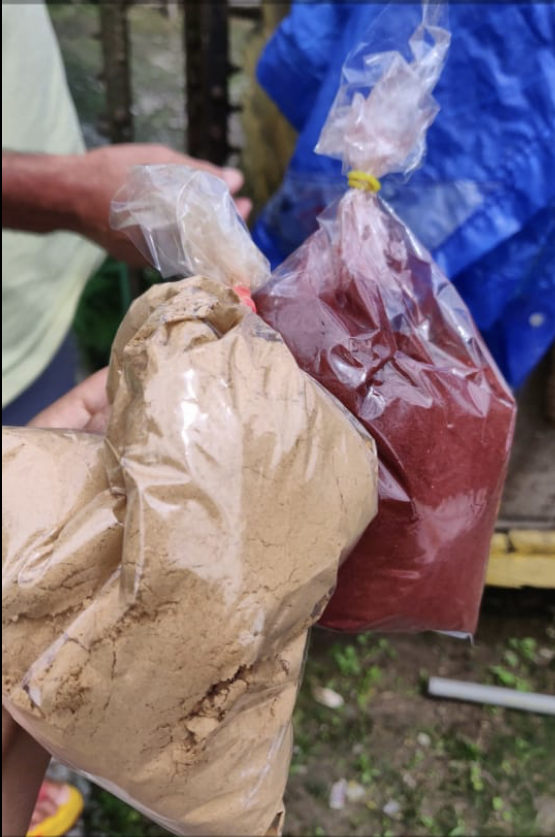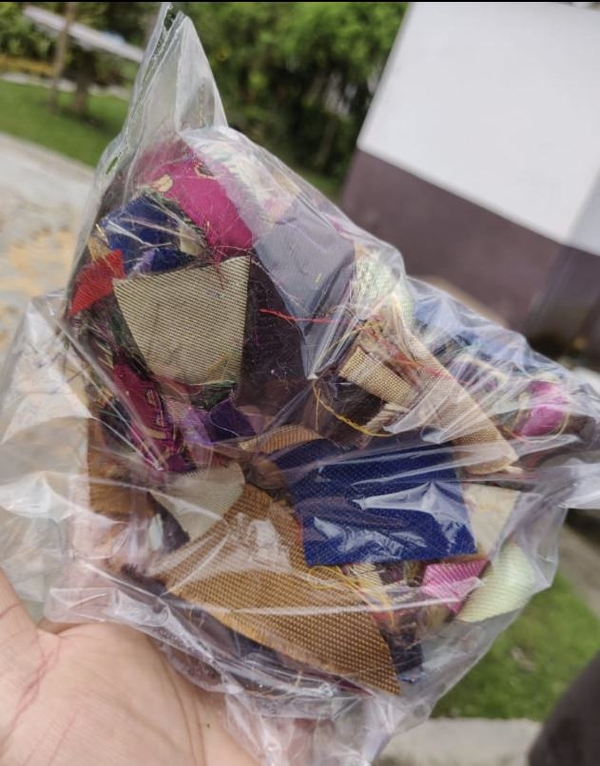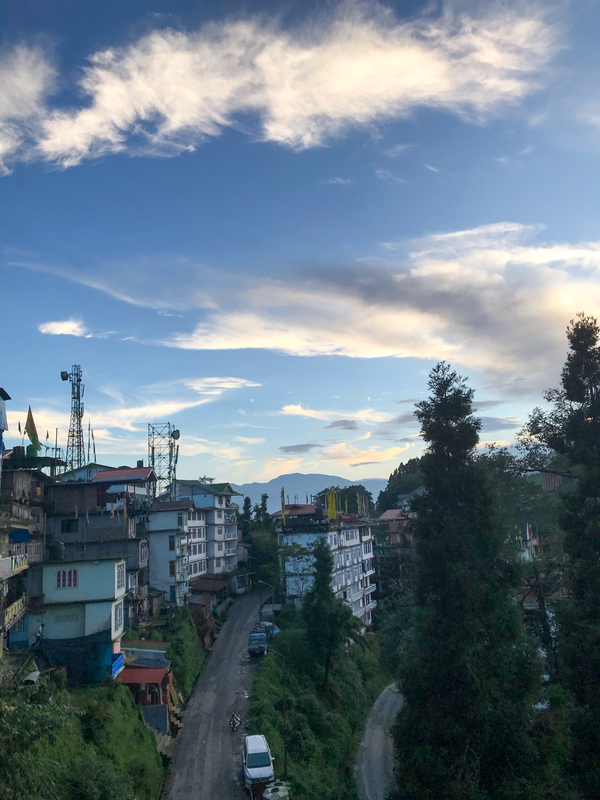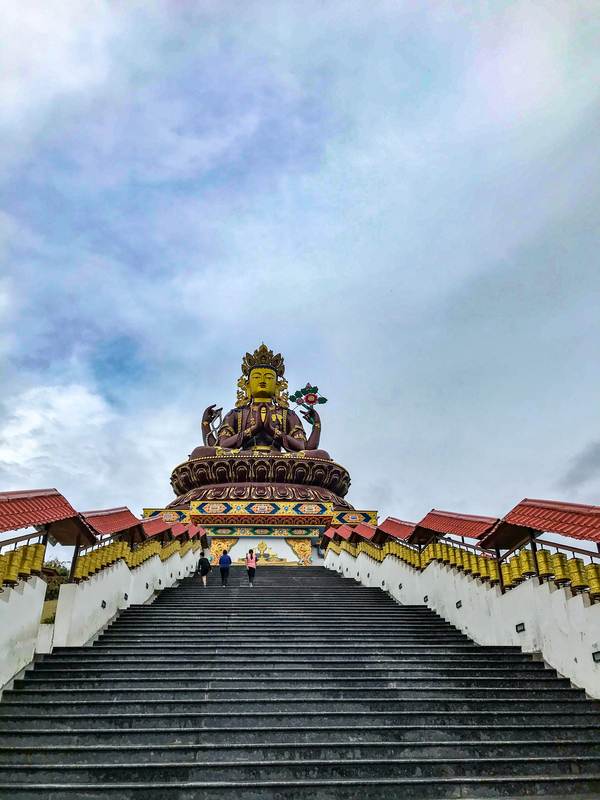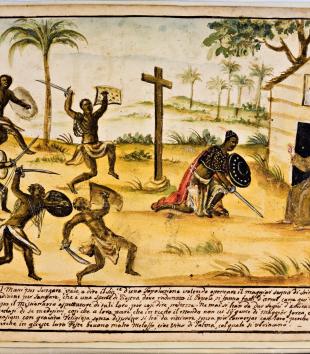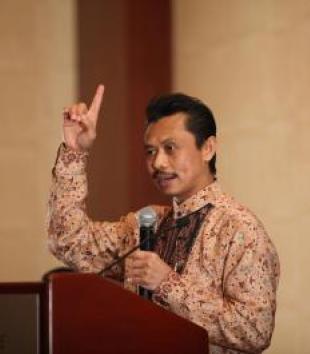Kalzang Dorjee Bhutia is a Non-Resident Senior Fellow at the Centre for Excellence in Himalayan Studies at Shiv Nadar University, India, and a Senior Research Scholar in the Institute of Global Value Enquiry, Germany. His research examines connections between ritual, land, water, air, foodways, and climate change, Indigenous and Buddhist cosmologies, and decolonial knowledge repair and reclamation in the Himalayas.
Sikkim, a small Indian state in the eastern Himalayas, is prone to landslides. Every year through the monsoon months, local residents and tourists have to negotiate their schedules and livelihoods around collapsing roads and moving houses due to torrential rain. Occasionally, these slipping banks become fatal, sweeping cars, residences and human bodies down into the currents of the mighty Teesta and the Rangit rivers below. Sikkimese Buddhist communities acknowledge that the heavy amount of rainfall during this period contributes to these disasters. But they do not interpret them as entirely “natural.” Instead, human behavior is often recognized as an important factor. According to Sikkimese Buddhist communities, some of the responsibility for these events should be attributed to problematic infrastructural projects, such as the construction of heavy concrete edifices on erosion-prone soil, and the detrimental impact of corrupt building contractors. Local people also acknowledge the presence of other agents, angered and agitated by the irresponsible and greedy human conduct they associate with overbuilding and deforestation, who send landslides as warnings and punishment.
In 2003, an enormous landslide between Gezing and Pelling, two urban centers in west Sikkim, cut the major state highway between the West District and the capital for days. Houses were destroyed, a number of their inhabitants hospitalized, and power and water supply was cut off. Food and rations supplied from the Indian border town of Siliguri were delayed, and deliveries to nearby villages dependent on Gezing market paused. Local Buddhist communities did not see this only as a symbol of state negligence and apathy towards road maintenance, which it was, but also considered the broader reasons behind the disaster.1
- 1Sikkim is a multi-cultural, multi-ethnic, multi-lingual state in northeast India. This article focuses on Buddhist communities, and specifically discusses Lepcha (also known as Rong in Lepcha language, or in Bhutia, Mon) and Bhutia (also known as Lhopo) residents of west Sikkim. The Lepcha people are Indigenous to the region and have a distinct language and cultural tradition. The Bhutia, or Lhopo, are held to have arrived from eastern Tibet in the thirteenth century, and presided over the Namgyal dynasty that ruled the kingdom between 1642 and 1975, when Sikkim became part of India. Bhutia language has many similarities with classical Tibetan, and uses Tibetan script. Here I will use the terms “Lepcha” and “Bhutia” for accessibility, as they are the most widely used in contemporary Sikkim. There are a number of other cultural and ethnic groups that practice Buddhism in Sikkim, and there are regional variations in Buddhist practices. Different ethnic communities in Sikkim also often participate in religious and cultural traditions outside of their own immediate community, so while this paper does focus on a specific locality, it should be noted that other non-Lepcha and Bhutia and non-Buddhist residents have also participated in the ritual traditions and cosmological systems described in the article. A full consideration of the dynamics of this participation is beyond the focus of this piece. For more on the dynamics of religion in Sikkim in other districts and areas, see anthropologist Anna Balikci’s Lamas, Shamans and Ancestors: Village Religion in Sikkim (Leiden: Brill, 2008) and political geographer Mona Chettri’s Ethnicity and Democracy in the Eastern Himalayan Borderland (Amsterdam: Amsterdam University Press, 2017).
Before contractors arrived with their road crews and heavy machinery to begin to clear the slide and repair the road, representatives from the local monasteries gathered at the site to offer sang (Tibetan: bsang), made from burning juniper and other fragrant woods and plants, to the local protector deities, or chökyong yullha zhidak (Tibetan: chos skyong yul lha gzhi bdag).1 This offering was an apology to the chökyong yullha zhidak, a way to acknowledge that the disaster had been invited by irresponsible human conduct in the area. As Gezing bazaar had grown larger than its historical boundaries due to the growth in population, septic tanks and garbage dumps had appeared in places that had previously been uninhabited by humans. As a result, the area developed a pungent smell, but it was not the smell that was offensive to the chökyong yullha zhidak, according to local lamas: it was instead the fact that the stream running through the area was being contaminated by waste, leading the five elements (earth, space, air, fire, and water) to become unbalanced. This imbalance attracted drib (Tibetan: grib), ritual pollution, to the area, and had directly led to the landslide.
The chökyong yullha zhidak that lived on the Gezing to Pelling road represented the many transdimensional inhabitants of Sikkim’s landscape that include deities of the mountains, lakes and rivers; spirits of forests, villages, and households; and protector deities responsible for ensuring that Sikkim continues to function as a place for humans and nonhumans to thrive. The unique ability for the landscape of Sikkim to foster this thriving has come from its position as a “Hidden Land” (Tibetan: sbas yul), prophesied by the eighth-century Buddhist tantric master Guru Rinpoche (Sanskrit: Guru Padmasambhava) as a safe haven for Buddhists in times of crisis. It also explains Sikkim’s classical Tibetan epithet of Denjong (Tibetan: ’Bras ljongs), which literally means the Valley of Rice, or as I choose to render it, the Valley of Abundance, due to the positive association between rice and abundance held in the Buddhist cultures of the Himalayas. Over the centuries following the visit of Guru Rinpoche, a number of Treasure Revealers (Tibetan: gter ston) received visions and prophecies (Tibetan: lung bstan) that compelled them to visit Sikkim and “open” it for Buddhist residents. One of the most influential of these Treasure Revealers was the Tibetan yogi Lhatsun Namkhai Jikme (Lha bstun nam mkha’ ’jigs med, 1597-1650/1654). It was the sang offering ritual that he is held to have revealed that was offered to the chökyong yullha zhidak after the 2003 landslide.
- 1Sikkim is a multi-lingual state, where the most commonly spoken language is Nepali. Lepcha and Bhutia communities also speak their own languages (see endnote 1). The language used for religious rites is classical Tibetan. Since this article focuses on religious rites developed in Sikkim that were published in classical Tibetan, and the Bhutia communities in Pelling speak a language with many similarities to classical Tibetan, unless otherwise noted I will use phonetics approximating local pronunciation and, when a word first appears, include the widely-known Wylie transliteration system that approximates Tibetan for all classical Tibetan terms.
This sang ritual is known as the Riwo Sangchö (Tibetan: Ri bo gsang mchod, The Mountain Smoke Offering), and it is now practiced in Tibetan, Himalayan and Inner Asian Buddhist communities around the world.1 Its performance in Sikkim has a special dimension for Sikkimese Buddhists, however, because the Riwo Sangchö is held to have been directly inspired by the landscape of the Hidden Land. In this article, I will explore the narratives connected to the history of the revelation and performance of the Riwo Sangchö in Sikkim, its connection with the landscape, and the significance of its localness for understanding multispecies relations in contemporary west Sikkim. This study contributes to discussions across religious studies, political geography, and anthropology about how transdimensional relations between humans, animals, spirits, plants, and other elements of the world are changing during the Anthropocene. In particular, my article makes two contributions to broader conversations: firstly, to the study of ritual as a site for understanding historical and cultural change in the Himalayas, and what it tells us about diversity in Himalayan Buddhism; and secondly, to discussions in political geography about layers of “built” environments and how they interact.
By thinking about the localness of this ritual, I do not mean to suggest that the Riwo Sangchö is an inherently environmentally friendly ritual that is only efficacious in Sikkim or has the same aims as contemporary environmental movements; I am also not arguing that the Riwo Sangchö can be understood in this way in other places it is practiced. Instead, my focus is on what narratives connected to the Riwo Sangchö tell us about how Sikkimese communities understand the history of their relationship with the land in which they live, and how contemporary performances of the ritual continue to facilitate inter-dimensional communication between humans and other beings resident in the landscape. To achieve this, I engage with work by a number of anthropologists and religious studies scholars of Tibet, Inner Asia, and the Himalayas, including Gillian Tan, Cathy Cantwell, and Jared Lindahl to think about how ritual, and especially sang, can function as a history, and more specifically here, environmental history; and also how ritual can provide insight into local understandings of environmental ethics. I then provide an overview of the Riwo Sangchö and its “recovery” as a pure vision for Lhatsun Namkhai Jikme in Sikkim, before considering its contemporary uses in both mitigating and responding to environmental change. I draw on close reading of classical Tibetan-language Buddhist sources related to Riwo Sangchö and my experience growing up in Sikkim in a Buddhist community in west Sikkim, as well as my experience carrying out scholarly research there for nearly three decades. My research in the Pemayangtse region has included participation in and observation of a wide range of Buddhist and Indigenous ritual life, and discussions with local ritual specialists and laypeople in Bhutia, Lepcha, and Nepali languages.
Considering the local history of Riwo Sangchö provides us with significant insight into how diverse religious sources and practices, including ritual, contribute to another level of the “built environment” of Sikkim as discussed by political geographers Duncan McDuie-Ra and Mona Chettri.2 Since Sikkim opened for tourism after its absorption into the Indian nation state in 1975, it has experienced enormous environmental change as urban centers have emerged from the forests and paddyfields of the landscape.3 While McDuie-Ra and Chettri’s research focused on the use of concrete in construction in contemporary Sikkim, I argue that the ritual regime of communication facilitated by the Riwo Sangchö is another historical example of constructing the environment and building a landscape. This process was not a straightforward case of the “Buddhacization” of the landscape, but instead represented a negotiation between Buddhist and Indigenous cosmologies, where the landscape that included the trees and mountains exercised agency.4 Acknowledging the role of Sikkim’s ecology in the shaping of this ritual is significant for understanding diverse and complex attitudes towards discourses of development in contemporary Sikkim, and in this article I add a religious studies perspective to critical discussions by political and cultural geographers including Chettri, McDuie-Ra and Mabel Gergan.5 It also serves as an example of how understanding local material and ecological histories can enrich our appreciation of the specific contexts in which rituals develop. Current developmentalist discourses often marginalize local perspectives and responses. Tracing the history and use of Riwo Sangchö provides us with an insight into environmental management and interaction from a Sikkimese Buddhist point of view, and poses as intervention to ahistorical narratives of ritual life.
- 1In this article, Riwo Sangchö, Denjong Nesol, and the names of other rituals are italicized for consistency as they are based on specific ritual texts. Types of ritual, such as sang offerings, are not italicized, since they are broader practices that may have many specific ritual iterations and texts in which they are enacted.
- 2Duncan McDuie-Ra and Mona Chettri, “Concreting the Frontier: Modernity and its Entanglements in Sikkim, India,” Political Geography 76 (2020): 2.
- 3For more on the history of tourism in Sikkim, see Maitreyee Choudhury, “Community Development and Tourism: The Sikkim Experience in the Eastern Himalayas,” in Mountains of the World: Community Development between Subsidy, Subsidiarity and Sustainability, Proceedings of the World Mountain Symposium, 30th September—4th October 2001, Interlaken, Switzerland. Berne: Swiss Development Cooperation, 1-13.
- 4For more on the Buddhacization of landscape in Sikkim’s sacred geography, see Anna Balikci-Denjongpa’s important article “Kangchendzönga: Secular and Buddhist Perceptions of the Mountain Deity of Sikkim among the Lhopos,” Bulletin of Tibetology 38, no. 2 (2001): 5-37.
- 5McDuie-Ra and Chettri, “Concreting the Frontier,” and Mabel Gergan, “Living with Earthquakes and Angry Deities at the Himalayan Borderlands,” Annals of the American Association of Geographers 107, no. 2 (2017): 490-98 and “Disastrous Hydropower, Uneven Regional Development, and Decolonization in India’s Eastern Himalayan Borderlands,” Political Geography 80 (2020): 102175.
Smoke Offerings in Broader Context: Complicating Buddhist Environmental Ethics
The Riwo Sangchö belongs to a category of ritual known as sang throughout the Tibetan, Inner Asian, and Himalayan world.1 It is widely understood and practiced as a rite of purification, where the fragrant smelling smoke (sometimes rendered as incense or fumigation) is understood as both cleansing and as nourishment for the many unseen inhabitants of the landscape. In his classic study of sang, Tibetan studies scholar Samten Karmay traces the history of smoke offerings back to pre-Buddhist history on the Tibetan plateau and its use in a variety of settings, including lay, religious, Bon, and Buddhist, as a rite with many potential uses, but especially associated with purification.2
One of the elements of unchanging tradition related to sang is that certain materials are collected to make sang due to their perceived efficacy.3 Tibetan religious studies scholar Chapbel Tseten Phuntsok stresses that specific types of materials are required for efficacious sang to be made. He writes,
The major ingredients for incense burning are fragrant trees and herbs, such as cyprus, juniper, rhododendrons and tansy. Those who are stylish concerning their incense ingredients add white and red sandalwood, aloewood, saffron, nauclea cadamba and others. The flour used in incense burning called Sang tsam (bsang rtsam) is made from barley flour mixed with butter and those who are stylish concerning the Sang tsam add the three whites (milk, butter and curd), the three sweets (honey, sugar and jaggery) and the powdered medicines. Having mixed them up, they put these into the incense fire. Also the first offering of wine and tea and offering water for purification are sprinkled on the incense fire.4
These materials are associated with purity, in contradistinction with materials that are deemed to hold or produce grib, ritual pollution. To demonstrate the relationship between purity and pollution in Tibetan societies, anthropologist Gillian Tan has outlined how different types of smoke are perceived. She emphasizes how smoke (Tibetan: du ba) is necessary for life among Tibetan pastoralists, but some smoke is problematic due to its association with forms of pollution. This type of smoke includes tobacco smoke, which is widely represented in historical accounts as a negative, defiling substance that “emits a smell that displeases the deities who subsequently act out their displeasure by striking calamities and wars on to humans.”5 This smoke is distinct from sang, which is a positive and powerful substance used for offerings.
Tan goes into more detail in another study. In a case study from Minyak, eastern Tibet (Tibetan: Khams Mi nyag), she outlines how sang creates “smoky relations” that bring about transformation for Buddhist nomadic communities. This is possible due to sang’s liminal existence that is “simultaneously material and non-material” and thereby breaks down dualities.6 She writes that “. . . entities are not only fortified or augmented by the smoky relations of sang but are also dependent on them for continued existence. Because smoky relations are an ongoing practice, and influence both human practitioners and worldly deities, the relationship may be more specifically articulated as a mutuality of becoming and un-becoming.”7 Her focus is on burning offerings to worldly deities that are susceptible to emotions and are capable of conferring both positive benefits and creating obstacles for their human co-inhabitants. She outlines how a local incarnate lama performed a sang offering on an area of pasture as part of a process of maneuvering “to call in a worldly deity from another place” to replace a deity that had previously fled the region after polluting acts occurred during the period of early Chinese influence in the region.8
Tan’s investigation of sang provides insight into the significance of smoky relations for interspecies communication, but also significantly affirms the importance of recognizing specific local contexts for considering the efficacy of the sang ritual. Religious studies scholar Jared Lindahl also discusses how sang offerings in Mongolia to mountain deities there are significant in the Mongolian landscape as an example of the ritual process through which local gods have been displaced by Buddhist pantheons. To him, these Mongolian sang rituals are exemplars of Buddhist dominance over Indigenous beliefs and appropriation of the Mongolian landscape.9
These context-specific examples provide important interventions in the field of Tibetan Buddhist environmental ethics. In popular stereotypes, Buddhism is often depicted as a “green religion,” with writers arguing that Buddhist concepts such as the interdependence of all things naturally lend themselves to an environmental ethic.10 Tibetan studies scholar Tenzin Atisha has argued that Tibetans were historically deeply concerned about the interrelationship between “all plants, animals, as well as the ‘non-living elements of the natural world’,” and that this concern was manifest in rituals including sang offerings.11 Tibetan studies scholars Toni Huber and Emily Yeh have critiqued these claims as ahistorical and as examples of contemporary politicized re-imaginings of the past to present a favorable image of Tibet to global audiences.12
However, religious studies scholar Cathy Cantwell provides nuance to these arguments in her critical analysis of the Earth Ritual (Tibetan: sa mchog). In her 2001 article, Cantwell argues that while the Earth Ritual cannot be understood as an environmentally friendly ritual according to contemporary understandings, it can be seen as part of a broader form of specifically Tibetan Buddhist environmental ethics. In the Earth Ritual, human desires are used to “bring about transformation in the practitioner’s experience” through violent Tantric visualization in which the Earth Goddess is first acknowledged and then “tamed” (Tibetan: ’dul ba). But this taming is not a straightforward taming. Cantwell argues that reciprocity between the earth and the practitioner is crucial as, if it were not, there would not be the necessity of periodically renewing this relationship by reenacting the ritual. In the ritual, “the environment is seen as a potential Buddha-field,” but this is not a case of the superimposition of a Buddhist artificial world. Instead, here the natural world’s attributes are re-defined, the self-other dualism between the practitioner and their world is dissolved, and instead the opposition of nature and culture, or human and not-human, is removed.13 As Tan has also argued, these rituals connected with landscape provide the opportunity for alternative interspecies relationships to emerge. These ritual traditions, along with other forms of narrative related to the ecology of a place, allow us to recognize a unique form of Buddhist environmental ethic that is historically situated.14
In this article, I will develop Tan’s and Lindahl’s insights on “smoky relations” to consider how the history of the influential sang ritual the Riwo Sangchö can be seen not only as a form of environmental ethics, but also environmental history. Historian Johan Elverskog has more recently argued that environmental histories of Buddhism have historically ignored the expansionist and exploitative attitude of Buddhist institutions towards the environment around them, and that environmentalist movements among Buddhists are all modern and demonstrate change within Buddhist institutions.15 In my analysis of the history of the Riwo Sangchö in Sikkim, I connect the promulgation of the Riwo Sangchö in Sikkim to the development and human exploitation of ecology in the state, as it was used in the building of Buddhist institutions that drew on materials drawn from the forests and mountains. However, rather than an extractive economy, whereby the Riwo Sangchö is performed to facilitate human expansion, I argue that the offering demonstrates the reciprocity highlighted by Tan and Cantwell, echoing the mutuality noted by folklorist Kikee D. Bhutia in her discussion of human-chökyong yullha zhidak relations.16 This reciprocity is demonstrated by the use of the Riwo Sangchö to both prevent and make recompense between humans and nonhumans when disasters occur. The Riwo Sangchö entails a giving back into the environment through smoke offerings, and often accompanies other types of environmental action that emphasizes mutuality, as opposed to exploitation.
- 1Forms of Buddhism found throughout Tibet, Inner Asia, and the Himalayas are diverse and too often lumped together as “Tibetan Buddhism,” due to their shared use of the classical Tibetan language. In this paper, I try to be specific about the type of Buddhism and where it is practiced in order to differentiate between various vernaculars; but also acknowledge the shared forms of practice between these Buddhisms.
- 2Samten Karmay, “The Local Deities and the Juniper Tree: A Ritual for Purification (bsang),” in The Arrow and the Spindle: Studies in History, Myths, Rituals, and Beliefs in Tibet ed. Samten Karmay (Kathmandu: Mandala Book Point), 380-412.
- 3Ibid., 405-6.
- 4Chabpel Tseten Phuntsok, “The Deity Invocation Ritual and the Purification Rite of Incense Burning in Tibet,” Tibet Journal 16, no. 3 (1991): 26. Minor edits for consistency of style by author.
- 5Gillian Tan, “Differentiating Smoke: Smoke as duwa and Smoke from bsang on the Tibetan plateau,” Anthropological Forum 28, no. 2 (2018): 130.
- 6Gillian Tan, “Smoky Relations: Beyond Dichotomies of Substance in Tibet,” in Exploring Materiality and Connectivity in Anthropology and Beyond, eds. Phillipp Schorch, Martin Saxer and Marten Elders (London: University College London Press, 2020), 146.
- 7Ibid., 147.
- 8Ibid., 151.
- 9Jared Lindahl, “The Ritual Veneration of Mongolia’s Mountains,” in Tibetan Ritual, ed. Jose Cabezon (New York: Oxford University Press, 2010), 226.
- 10An influential example of work that develops these associations between Buddhism and environmentalism is Stephanie Kaza and Kenneth Kraft, eds. Dharma Rain (Boston, MA: Shambhala, 2000).
- 11Tenzin Atisha, “The Tibetan Approach to Ecology,” Tibetan Review 25 (1991): 9-14.
- 12Toni Huber, “Green Tibetans: A Brief Social History,” in Tibetan Culture in the Diaspora, ed. Frank Korom (Vienna: Verlag der Österreichischen Akademie der Wissenschaften, 1997), 103-19 and Emily Yeh, “The Rise and Fall of the Green Tibetan: Contingent Collaborations and the Vicissitudes of Harmony,” in Mapping Shangrila: Contested Landscapes in the Sino-Tibetan Borderlands, eds. Emily T. Yeh and Chris Coggins (Seattle: University of Washington Press, 2014), 255-78.
- 13Cathy Cantwell, “Reflections on Ecological Ethics and the Tibetan Earth Ritual,” The Eastern Buddhist 33, no. 1 (2001): 113-19.
- 14A recent work that develops the idea of spatially situated ethics in the Himalayas is Karine Gagné, Caring for Glaciers: Land, Animals, and Humanity in the Himalayas (Seattle: University of Washington Press, 2019).
- 15Johan Elverskog, The Buddha’s Footprint (Philadelphia: University of Pennsylvania Press, 2020).
- 16Kikee D. Bhutia, “‘I exist therefore you exist, we exist therefore they exist’: Narratives of Mutuality between Deities (Yul-lha gzhi bdag) and Lhopo (Bhutia) Villagers in Sikkim,” Folklore 75 (2019): 191-206.
Smoke Offerings in the Sikkimese Context: The History of the Riwo Sangchö in Sikkim
How does the ritual demonstrate this? The Riwo Sangchö itself is quite a short text, and can be performed as a short or long ritual. In west Sikkim, sang is offered on a daily basis in the morning and in the evening to cleanse domestic residences. Additionally, the Riwo Sangchö is often performed to purify an area, particularly during auspicious days of the Buddhist lunar calendar, in support of other ritual activities, or during childbirth, when people are sick or following death. It may also be performed to prevent, or in response to, misfortunes broadly construed, related to health, economic stability, and social relations.
Undertaking the Riwo Sangchö begins with the preparation of 108 ingredients, including different types of pine and juniper trees and other pleasant-smelling substances (the longer list is discussed below).1 Branches of trees are gathered and made into kindling for the fire, and pine tree branches are gathered for offerings, a day in advance to clear out insects. This preparation is undertaken by lamas or laypeople, and the materials will be assembled in a clean place above the area that needs to be cleansed. Ideally, this will be on a hill or the top of a building in a sangbum (Tibetan: bsang bum), a repository with openings designed to be used for smoky offerings. Top quality wood, free of insects, that produces good charcoal is gathered and set on fire by the propitiant, who will often remain beside the fire adding substances and tending it.
At the beginning, the lama, or ritual officiant presiding over the Riwo Sangchö will recite the refuge and lineage prayer of Lhatsun.2 He or she will then invoke “om ah hum” three times and sprinkle purifying water on the fire, which can also serve to calm the flames. Once the fire has burned into charcoal, the sang materials are added, starting with green juniper which is cut and added to the charcoal. Other ingredients such as the three whites and three sweets (discussed above) are slowly added until the smoke begins to billow out of the fire. The sang has a strong smell. It makes the eyes of the residing lama and the people in attendance prickle, and sometimes even leads to sneezing or coughing. The lama then begins the prayer, standing or sitting near to the fire but not so close that the smoke prevents them from reading their text. Some lamas will do a simple recitation of the prayer; others will accompany their prayer with a bell (Tibetan: Dril bu) and small hand drum (Tibetan: Da ma ru). Lay propitiants may stand near the lama during this process, or may be occupied helping tend the fire or making refreshments for the people gathered there to join the lama in the offering.
- 1I am currently compiling a list of these 108 ingredients for future publication.
- 2In this article, I will refer to these figures as lama for consistency, though other scholarship on sang has noted that sang rituals are also performed by laypeople. In west Sikkim, laypeople prefer to invite lamas either from their own family or one of the local monasteries to perform the Riwo Sangchö. In Sikkim, most monasteries are made up of lay Tantrists (Tibetan: sngags pa སྔགས་པ) who have varying level of ritual expertise. The most experienced ritual experts may also be scholars or meditation masters, and they may or may not be incarnates (Tibetan: sprul sku སྤྲུལ་སྐུ་). Women can also perform this ritual, but here I refer to “he or she” since most lamas in Sikkim identify as male.
The prayer of Riwo Sangchö takes the form of an offering to unseen beings with an aspiration for them to reach enlightenment and for obstacles to be cleared. The text invokes all the different classes of beings, from those at the top of the Buddhist universe model such as Buddhas, gurus, and yidams, down through the beings of the six realms to demons and negative spirits.1 Finally, the ritual offers a dedication for the welfare of all sentient beings. The text may be recited several times (and may even go on for an entire day) depending on the situation. At the end of the text, the lama allows the sang to burn off slowly, while smoke pervades throughout the local environment, across the horizon, and across the world, representing all the beings who should benefit. At times, additional prayers may also be recited at the end of the text with further dedications for all beings. Eventually, the lama departs and the smoke burns down into a pile of ashes. The ashes either remain in the sangbum, or are collected and scattered in a clean area by the lay sponsors or the lama’s assistants.
- 1The classical Tibetan text of this ritual is published as Lha bstun nam mkha’ ’jigs med, “Ri bo bsangs mchod,” in Rig ‘dzin srog sgrub (Delhi: Chos spyod dpar skrun khang, 2000), vol. 1, 829-34. A full translation of the ritual text is available at Lotsawa House, https://www.lotsawahouse.org/tibetan-masters/lhatsun-namkha-jigme/riwo-sangcho.
The focus in the Riwo Sangchö on benefitting beings as vast as space (or as vast as the smoke that pervades the universe) makes it appear to be a general Buddhist text that reflects Buddhist soteriological concerns. In Tibetan, Inner Asian, and Himalayan Buddhism, rituals are often understood as having “relative” and “ultimate” meanings, corresponding to worldly and soteriological goals of different practices. Buddhist lamas providing commentaries on the Riwo Sangchö often emphasize the “ultimate” meaning of the text, and how it functions as a purifying visualization that can help an individual practitioner overcome dualism and develop compassion.1 Tan has also noted this focus of sang rituals.2
However, this interpretation does not consider the history behind this practice, including the time, place, and context in which this specific sang ritual arose. Taking these factors into account inspires a broader understanding of why this ritual was seen as efficacious in 2003 as a response to the Gezing landslide, and why it continues to be widely practiced. The colophon at the end of the text as it has been compiled and published as part of the Rigzin Srokdrup (Tibetan: Rig ‘dzin srog sgrub, The Gathering of the Knowledge Holders) notes that the text was set down “in accordance with the dakini’s instructions . . . when revealing the hidden land of Sikkim.”3 Lhatsun is held to have “revealed” this text, previously hidden by Guru Rinpoche, when he arrived at the border of Sikkim. This process of revelation is widespread in Tibetan Buddhism (particularly among Nyingma and Kagyu traditions), and his “pure vision” (Tibetan: dag snang) was inspired by interaction with a dakini (Tibetan: mkha’ ’gro), a powerful liminal female spirit who protects the dharma.4 The nature of this revelation is tied intimately to landscape, which is common among revealed texts.5 The revelation was intended to deal with the specific beings resident in Sikkim’s landscape, and to allow for Lhatsun to engage in the promulgation of Buddhism there. Part of this promulgation included constructing large monasteries that managed landed estates and collected taxes on behalf of the kings of the Namgyal dynasty. According to Sikkimese historical traditions, Lhatsun participated in the enthronement of the first king of the Namgyal dynasty in 1642, and his lineage became influential in the royal institutions of the state thereafter.6
- 1An example of a commentary that highlights the Buddhist themes in the text is translated as Gyalse Shenpen Taye, “The Gentle Rain of Benefit and Joy: An Explanation of the Practice of Sang Offering,” Lotsawa House https://www.lotsawahouse.org/tibetan-masters/gyalse-shenpen-taye/gentle-rain.
- 2Tan, “Smoky Relations.”
- 3Lha bstun nam mkha’ ’jigs med, “Ri bo bsangs mchod,” Lotsawa House.
- 4Nyingma (Tibetan: Rnying ma རྙིང་མ་) and Kagyu (Tibetan: Bka’ brgyud བཀའ་བརྒྱུད་) are two of the four major traditions of Tibetan Buddhism, which also include the Sakya (Tibetan: Sa skya ས་སྐྱ་) and Geluk (Dge lugs དགེ་ལུགས་). There are also a number of smaller traditions, such as the Jonang (Tibetan: Jo nang ཇོ་ནང་). At times, the Tibetan Indigenous tradition of Bon (Tibetan: Bon བོན་) is also included in this schema as a fifth major tradition, but is a distinct religion in its own right.
- 5For more on place and Treasure discovery, see Tulku Thondup, Hidden Teachings of Tibet (Boston, MA: Wisdom Publications, 1997).
- 6For a critical perspective on the history and historiography of Sikkim, see Saul Mullard, Opening the Hidden Land (Leiden: Brill, 2011).
This colophon alone does not tell us much about the local history of the specific ritual text of the Riwo Sangchö. However, other sources provide us with more information. The History of Sikkim is a unique historical source composed by the ninth king of the Namgyal dynasty of Sikkim, Thuthop Namgyal (Tibetan: Mthu stobs rnam rgyal) and his wife, Queen Yeshe Dolma (Tibetan: Ye shes sgrol ma), while they were under house arrest by British authorities in 1908. The text was written as a response to what they perceived to be misrepresentations of Sikkimese history and culture in the British-sponsored Gazetteer of Sikhim that was compiled by H.H Risley and published in 1894.1 The History of Sikkim is based on compiled manuscripts and oral sources about the kingdom of Sikkim’s history as it was understood by the king and queen. The early history in particular emphasized Sikkim’s status as a prophesied Hidden Land and goes into extensive detail about the visit of Lhatsun Namkhai Jikme to “open” the Hidden Land. Since during his visit he also enthroned the first king of the Namgyal dynasty, the king and queen’s concern for recording this part of Lhatsun’s narrative is understandable, as it reconfirmed their legitimacy as sovereign rulers.2 However, the narratives of The History of Sikkim are also important for relating the received history of many elements of Buddhist practice in Sikkim in the early-twentieth century. The section on Lhatsun is a vivid example of this. In the book, the narrators relate that when Lhatsun first arrived in Sikkim, he came from the north to a place called Chukarpangshung (Tibetan: Chu dkar spang gshongs) in the border between Tibet and Sikkim.3 There,
. . . the Lepcha Tekong Salang (Tibetan: Mon The kong za lang) came to receive him. Later when Lhatsun was opening the door to the sacred place, Mon Tekong Salang gave him a thorough introduction to Traktongrong (Tibetan: Khrag ’thung rong), Phagmorong (Tibetan: Phag mo rong), Lhari Nyingpug (Tibetan: Lha ri snying phug), Taden Yangsangpug (Tibetan: Rta mgrin yang gsang phug), Dechenphug (Tibetan: Bde chen phug), and the other great caves, as well as many other sacred places. This led to the compilation of the guidebook (Tibetan: gnas yig) [to the sacred landscape]. Tekong Salang lived for three hundred years and his throne remains at Lhari Nyingphug; his footprints are imprinted at Thagthongrong, and the bamboo and tobacco plants [that he planted] are still there, along with his grave.4
Tekong Salang’s presence and role in Lhatsun’s “revealing” of Sikkim is not mentioned in the colophon. However, his significance to Lhatsun, and their collaborative process, is further affirmed by his presence in the popular folk song, the Denjong Chakrab (Tibetan: ’Bras ljongs chags rabs, The Establishment of Denjong). The relevant verse declares,
How fortunate and gratifying that the keeper of the Hidden Land, there was a keeper of the Hidden Land,
How fortunate and gratifying that the keeper of the Hidden Land was Tekong Salang, that keeper of the Hidden Land . . .5
In this song and The History of Sikkim excerpt Tekong Salang is called the “Keeper” of the Hidden Land, and his guidance of Lhatsun directly results in the compilation of Lhatsun’s guide to the sacred places of Sikkim, which suggests a collaboration as opposed to domination. This collaboration demonstrates the Indigenous Lepcha cultural influence on the development of Sikkim’s “built” sacred Buddhist geography. Interestingly, by the seventeenth century Lepcha communities already had an agricultural practice known as “slash and burn,” in which controlled fire was used in preparing land for cultivation. Bongthing, ritual specialists that practice Indigenous Lepcha traditions, also use burned offerings. Both Buddhist and Indigenous rituals incorporated smoky relations. The meeting of Buddhism and Indigenous traditions is not unique to Sikkim. It has been characteristic of Buddhism’s incorporation into the cultural geography and politics of the Himalayas for more than a thousand years. Treasure traditions (Tibetan: gter ma) that are held to have been hidden by Guru Rinpoche and later rediscovered and revealed by his students (such as Lhatsun) have been particularly important as a way to bring together different perspectives of the landscape and to make political claims over territory.6
This local influence is also present in the list of deities and spirits who are invoked in the sang ritual text. In the Denjong Nesol rite (Tibetan: ’Bras ljongs gnas gsol; English: Earth Propitiation) that is also believed to have been revealed by Lhatsun Namkhai Jikme, there is an additional section that elaborates on how sang should be offered, and more specifically, to whom. The list of beings incorporates both members of the Buddhist pantheon and Indigenous spirits. It sorts the beings of Sikkim into three categories: the deities at the top of the landscape, the spirits in the foothills, and the spirits in the valleys. The text states that sang can clear “external, internal and secret” obstacles for all of the demons, spirits, and gods (Tibetan: bdud, mtshan, lha) of those places.
- 1H.H. Risley, The Gazetteer of Sikhim (Calcutta: Bengal Secretariat Press, 1894).
- 2Tashi Tsering, “A Short Communication about the 1908 ’Bras ljongs rgyal rabs,” Bulletin of Tibetology 48, no. 1 (2012): 33-60.
- 3For additional detail on the historical context and chronology of these events, see Mullard, Opening the Hidden Land.
- 4My own translation, Mthu stobs rnam rgyal and Ye shes sgrol ma, ’Bras ljongs rgyal rabs (Gangtok: Tsuklhakhang Trust, 2003), 52.
- 5The lyrics to this song are provided in Bhutia and English in P.T. Gyamtso, Denjong Sunglu (Gangtok: Denzong Lhomen Kiduk, 2009), 20-22. Since the published version found in this book omits a number of verses, here I offer my own adapted translation with the lyrics I was taught as a child that featured Tekong Salang.
- 6For more on how Treasure revealers participated in this process in nineteenth-century Kham, see Alexander Gardner, “The Twenty-Five Great Sites of Khams: Religious Geography, Revelation, and Nonsectarianism in Nineteenth-Century Eastern Tibet,” unpublished Ph.D. dissertation, University of Michigan, 2006.
Above all the deities is Dzonga (Tibetan: Mdzod lnga) the mountain deity who presides over all of Sikkim.1 After him comes Pawo Hungri, the Great Demon Dharma Protector (Tibetan: Bbud bstan chen po dpa’ bo hung ri), followed by the twenty-one worldly vow holders. In the valley, there are one hundred and nine lakes, including Rigzin Latso (Tibetan: Rig ’dzin bla mtsho), Jampal Latso (Tibetan: ’Jam dpal bla mtsho), Tadring Latso (Tibetan: Rta mgrin bla mtsho), Yangdak Latso (Tibetan: Yang dag bla mtsho) which are all home to deities of the place (Tibetan: sa bdag), Naga spirits associated with water (Tibetan: klu), lords of the trees (Tibetan: gnyan), and Tenma Goddesses (Tibetan: Bstan mar). There are also lakes where deities associated with the Phurba Kilaya, female spirits and worldly deities are resident, along with lakes associated with Taksa (Tibetan: Trag shad), Maning (Tibetan: Ma ning), and all the eight classes of demons and wrathful deities. The lakes can be sorted into three general categories: the upper white milk lakes are residences of the gods; the middle red blood lakes are residences of tsan spirits; and the lower blue medicinal lakes are associated with lower beings. All of the important sacred sites including the sacred caves of Orgyan Dechenphug (Tibetan: O rgyan bde chen phug), Khandro Sangphug (Tibetan: Mkha’ ’gro gsang phug), Lhari Rinchenphug (Tibetan: Lha ri rin chen phug), the monastery of Pemayangtse (Tibetan: Pad ma yang rtse), the royal palace of Rabdentse (Tibetan: Rab ldan rtse), and the waterfall of Pagmorong (Tibetan: Phags mo rong) are home to chökyong yullha zhidak. The Denjong Nesol text lists all of them, and then states that the sang will reach “the four directions and eight cardinal points” to satiate all the chökyong yullha zhidak with smoke from the “king of trees,” the pine. This type of ecological detail situates the performance of the Riwo Sangchö within Sikkim’s landscape. Along with details about the history of Lhatsun’s revelation of the ritual details, the role of the Riwo Sangchö in other rituals such as the Denjong Nesol demonstrate its significance for Sikkimese communities, even as it has been widely adopted throughout Buddhist communities on and around the Tibetan plateau and in Inner Asia.
- 1Dzonga is also known as Kanchenjanga, the third highest mountain in the world (spelt variously as Kanchenjunga, Kangchendzonga, Khangchendzonga), or locally as Kanchendzonga (Tibetan: Gangs chen mdzod lnga གངས་ཆེན་མཛོད་ལྔ་). Balikci-Denjongpa provides a detailed overview of Dzonga in her article “Kangchendzönga: Secular and Buddhist Perceptions of the Mountain Deity of Sikkim among the Lhopos.”
The Complexity of Reciprocity: Local Environmental Histories of Sang in Sikkim
The Denjong Nesol’s description of the pine tree as “the king of trees” is especially salient since pine trees are present throughout Sikkim.1 Though the borders of the state have changed over time since Lhatsun’s visit in the seventeenth century, when he visited he encountered the diverse ecosystem of the state, spanning from the alpine trees around Dzongri where he descended from the mountain pass out of Tibet, down to the subtropical highland climate of west Sikkim. The availability of these and other plants facilitated the popularization of sang offerings, and also shaped what was offered in sang.
The Riwo Sangchö text provides a specific prescription of what should be put in the sang and how it should be offered. In contemporary Sikkimese communities, the burnt offerings used in sang are not sold, but instead are gathered by laypeople and lamas in villages according to their needs. In a village setting in west Sikkim, sang includes juniper, pine, sandalwood, the three whites (Tibetan: dkar gsum, including curd, milk, and butter), and three sweets (Tibetan: mngar gsum, including honey, molasses, and sugar), Tibetan sage, barley, cloves, tsampa (Tibetan: rtsam pa), tea, nutmeg, cassia bark, saffron, sesame seeds, coconut, silk, and ground metals. Many of these materials are gathered from the local environment; some, such as coconut, silk, and ground metals, are traded for or purchased from the bazaar (a selection of these substances are represented in photographs in this article, see Figs. 6-12). These materials are all associated with purity, and it is noteworthy that many are edible to humans as well, demonstrating ideas about shared transdimensional nourishment.
- 1This part of the Denjong Nesol text can be found published as ’Bras ljongs gnas kyi bsang dang gsol ki’i rigs bzhugs pa’i dbu phyogs lags so (Privately published, date unknown, in possession of author), 28-31.
Cantwell has argued that assuming rituals related to the environment are environmentally friendly is problematic in the Tibetan context, as these rituals do not actually have a physical outcome.1 Similarly, the idea of sang as reciprocal in its benefits appears questionable, since preparation involves cutting off branches of healthy trees and the use of other environmental materials. However, in a west Sikkim context, the preparation of sang does bring environmental benefits. As a child when my family prepared sang offerings, my parents stressed the importance of gathering the materials with careful intention. My siblings and neighbors have continued to transmit this message to their children. For example, only the required amount of any tree branch or plant should be taken; and if there was only a small amount left, it was preferable not to remove it, but instead look elsewhere for other materials. For the trees, such as juniper and pine, it was important to check that their bark and leaves were healthy before removing cuttings of branches for the offering, and to not take too much. Additionally, removing cuttings of branches for sang is seen as beneficial to the tree, as cutting promotes regrowth and continued health. Tree materials can only be burnt on sang a day after they have been gathered in order to allow insects to leave the branches so they will not be harmed. In this way, sang is practiced as part of a system of local forest management.
- 1Cantwell, “Reflections on Ecological Ethics and the Tibetan Earth Ritual,” 111.
Cantwell has argued that assuming rituals related to the environment are environmentally friendly is problematic in the Tibetan context, as these rituals do not actually have a physical outcome.1 Similarly, the idea of sang as reciprocal in its benefits appears questionable, since preparation involves cutting off branches of healthy trees and the use of other environmental materials. However, in a west Sikkim context, the preparation of sang does bring environmental benefits. As a child when my family prepared sang offerings, my parents stressed the importance of gathering the materials with careful intention. My siblings and neighbors have continued to transmit this message to their children. For example, only the required amount of any tree branch or plant should be taken; and if there was only a small amount left, it was preferable not to remove it, but instead look elsewhere for other materials. For the trees, such as juniper and pine, it was important to check that their bark and leaves were healthy before removing cuttings of branches for the offering, and to not take too much. Additionally, removing cuttings of branches for sang is seen as beneficial to the tree, as cutting promotes regrowth and continued health. Tree materials can only be burnt on sang a day after they have been gathered in order to allow insects to leave the branches so they will not be harmed. In this way, sang is practiced as part of a system of local forest management.
- 1Cantwell, “Reflections on Ecological Ethics and the Tibetan Earth Ritual,” 111.
Until the late-twentieth-century Pelling was a small village on the ridgeline below Pemayangtse Monastery, the royal monastery of Sikkim established by Lhatsun Namkhai Jikme. Beyond its pines, Pelling offered one of the most stunning viewpoints for Mount Kanchendzonga, and also served as a gateway on the single road into the heartlands of west Sikkim. In the mid 1990s, Pelling residents began to build large concrete hotels to cater to the large numbers of mostly domestic tourists from West Bengal, often with financial investment from tenants from West Bengal that leased these hotels, and the Pelling Tourism Development Association was established.1 There are now dozens of tall concrete hotels, and before the coronavirus led to a halt to tourism in the state in 2020, these hotels regularly reached full occupancy during Pelling’s annual summer tourist season. There is so much demand in fact that hotels have also started to be built in the nearby villages of Chombong (Bhutia: Gcong phung) and Singyang (Bhutia: Zin g.yang), and ecotourism initiatives have become popular in villages along the Pelling road such as Darap (Bhutia: Da rap) and Sindrang (Bhutia: Zin da rang).
These new structures, and the infrastructure that supports them, have led to unprecedented challenges for people in Pelling. As flat land has become a rare commodity, hotels are built on steep land, and the forest clearing that is required for building leads to erosion and the potential for increased damage during earthquakes. There is still only one road into the town, so during the tourist season there are traffic jams. While west Sikkim historically had an abundance of water sources tapped from Kanchendzonga’s glaciers, water shortages are frequent during the tourist season. Additionally, septic tank, road, and electricity maintenance to compensate for the influx of temporary residents create challenges for local government departments.
- 1Jayatra Mandal and Puspita Sengupta, “The impact of tourism on livelihood and environment in West Sikkim: A Case Study of Pelling,” Indian Journal of Landscape Systems and Ecological Studies 38, no. 1 (2015): 2.
Sang as Local Environmental Ethics: Contemporary Performances of the Riwo Sangchö in Sikkim
Gathering the materials for sang offerings with good intention is especially important for ensuring favorable outcomes. In Sikkim, sang is prepared using mostly widely available materials; historically, it has also been associated with key moments in Sikkimese history. Without offering sang, Lhatsun could not have proceeded into Sikkim from the mountain passes; it directly facilitated his ability to open the Hidden Land and set in motion Sikkim’s Buddhist history. Most importantly, Lhatsun’s offering of sang acknowledged the presence of the local spirits of the landscape and their significance. In Sikkim today, people continue to seek the blessings of these transdimensional beings before any major activity that might disturb their environment, and also to apologize and make reparations for their behavior.
These offerings are necessary in Sikkim’s rapidly changing landscape. In the last century, Sikkim has seen enormous changes as urban centers have sprouted up on the sides of its steep hills, replacing forest and agricultural land, and shifting water sources. These changes have been especially obvious in Sikkim’s West District. The region has seen huge development in infrastructure over a very short period of time to facilitate tourism focused around the mountain vista of Kanchendzonga. Historically, west Sikkim was important as the center of the Buddhist sacred landscape, and the site of the capital of the Buddhist Namgyal dynasty that ruled the state from 1642 until 1975. However, after the capital moved to Tumlong in north Sikkim in the nineteenth century and British influence in the state increased with the development of the post of the Political Officer, west Sikkim’s infrastructure did not develop. Instead, Gangtok became the state’s urban center and has become an enormous, sprawling concrete metropolis. In the early to mid-twentieth century, west Sikkim became known for its agricultural abundance and, since tourist permits to the border state were hard to come by, only a small group of trekkers and guests of Gangtok elite ventured westward. This changed after Sikkim was absorbed into the Indian Union in 1975. In 1990, the state eased restrictions on tourist movement and communities in west Sikkim began to build hotels, roads, and other infrastructure to cater to tourists.1
- 1It should be noted that as of 2020 foreign tourists are still only permitted to visit Sikkim for a period of two months after obtaining an Inner Line Permit (ILP).
Taking Permission
As the built environment of Pelling has changed radically, so too have local people’s relationships with the chökyong yullha zhidak and other unseen residents. In order to prevent disruption to the local spirits, Buddhist residents are careful to continue their ritual maintenance of reciprocity in Pelling. Most importantly, before hotel construction begins, aspiring hotel builders will invite lamas, mostly from Pemayangtse, to undertake consecration (Tibetan: rab gnas) rituals.
This consecration is known as Sa da lu nyen (Tibetan: sa bdag klu gnyan), or the Offering to the Lord of the Soil, the Nagas (Tibetan: klu) and the Local Spirits. The name itself represents the different classes of deities and spirits present in the landscape, referring to the soil (sadag), any water sources (lu) and other materials (nyen, who are often rendered as gods of the trees). Before beginning the rite, lamas are invited to consult on whether the place is appropriate or not for construction. This acts as a kind of spiritual Environmental Impact Assessment in lieu of building permits from the state, where lamas will check if there is any lord of the land (Tibetan: sa bdag po) who may be present there. Places that often have lords of the land present include water sources, such as wetlands, marshy areas, and streams; this land is often structurally unsound and prone to erosion, but it is also the residing place of naga spirits that need to be left alone, lest they are angered and bring illness to human residents. At times, spirits may manifest as large rocks or boulders, and moving them or blasting them with dynamite can bring illness and misfortune to human builders. Doing a thorough check for any unseen residents is therefore very important before undertaking the consecration rite.
The consecration rite is reciprocal in its structure. After offering Riwo Sangchö several times to purify the place, the lama will then propitiate the local spirits and offer them gifts. These are materials such as water and minerals, and are enclosed in a bumpa (offering vase) and buried in the soil. This gift is intended to consolidate the relationship between the local spirits and prospective human residents, creating an environment where a building can last and its human residents prosper. This offering is also given to Kanchendzonga and the other deities of the land, who can always “cut funding” or create other obstacles to humans if not propitiated appropriately. At the end of any building project, the Khimsa Tashi (Tibetan: Khyim sa bkra shis; English: Auspicious New House) ritual is undertaken, where lamas are again invited and give offerings to the spirit of the place.
Making Reparations
In the last twenty-five years, Pelling has seen many consecrations as new hotels have multiplied in the landscape. However, these consecrations have not been enough to compensate for the significant environmental changes that have taken place. In the early 1990s, an enormous landslide at the Hungri (Bhutia: Hung ri) stream, which flows under the cliff that is the base of Pelling town, was seen as evidence of the displeasure of the nonhuman residents of the town. At the time, the revered Tibetan-Sikkimese lama Yangthang Rinpoche (Tibetan: G.yang thang rin po che, 1930-2016) was a resident of Pelling. He pronounced that the landslide was not a natural disaster, but instead had been created through the unforeseen impact that hotel building and other forms of “development” had brought to Pelling. Additionally, he said that the construction of hotels had been undertaken in places where lu, or naga spirits associated with water, were resident, and that the mismanagement of septic tanks, dirty water and other types of waste were agitating other spirits, the lu and nyen. He prescribed an annual performance of Riwo Sangchö to rebalance this and to give offerings to all of the deities and spirits. The Riwo Sangchö was performed along with the making of offering vases that were buried below hotels on the top of the Hungri cliff and along the adjoining ridge. Local Buddhists expanded on this directive and began a tradition of doing an annual Denjong Nesol for the area that rotated between the residences in Pelling until the 2010s, when it was re-homed in the Singyang Mani Lhakhang, a temple near Pelling.
The landslide in 2003 was another example of the impact of urbanization, as the growth of Gezing, the district capital, led to businesses and farms moving into new areas where there were previously no human residents. More recently in 2011, another significant landslide took place at Sangha Choeling monastery (Tibetan: Sangs sngags chos gling) above Pelling. In that year, a local contractor began road construction up to the important Sangha Choeling meditation center in preparation for a giant statue of the bodhisattva Avalokitesvara to be built there. After some heavy rain, the road that had been dug out collapsed, sending down rocks and mud all the way to the Rimbi river. It narrowly missed Singyang village. Distraught local community members again went and requested advice from Yangthang Rinpoche; he instructed them to conduct a large Riwo Sangchö ritual to apologize to the spirits resident in the Dorje Phagmo Lhakhang at the monastery, who were angry because of the use of dynamite in the road construction. The rituals went on for three days and after that, despite the challenging terrain, the road was eventually completed. In 2018, the Avalokitesvara statue was opened to the public—following a presentation of Riwo Sangchö, of course.
In these instances, the Riwo Sangchö functioned to repair transdimensional relations and re-establish reciprocity between local human and nonhuman residents in the Pelling area of west Sikkim. Mabel Gergan has recently discussed how state-led development projects (especially hydroelectrical dams) have led to new stresses on human inhabitants in Sikkim, and how disasters in Sikkim’s landscape are understood in local cosmologies as warnings from the deities about inappropriate human conduct. Ritual practices and narratives have responded to these changes and the anxieties brought by them, which “displays that cosmological worlds have room for flexibility and openness.”1 Acknowledging the layers of these practices and cosmologies allows us to think about environmental change beyond simplistic paradigms of loss, and to imagine alternative ways for seen and unseen beings to live together in the environment of the anthropocene.2 The Riwo Sangchö and its accompanying prescriptions allow for residents in the quickly growing urban tourism hub of Pelling to consider human-environment relations and responsibilities in alternate ways, and also have cautionary effects in discouraging humans from over-development. In this way, this latest use of Riwo Sangchö represents another moment in transdimensional reciprocity in Sikkim’s landscape.
Conclusion
As the eastern Himalayas undergo rapid environmental change, new sources and alternative readings of cultural resources including rituals can provide us with a different way to understand environmental histories of the region, and to recognize both what is no longer present and new emerging formations. The Riwo Sangchö is a ritual exchange that facilitates smoky relations between humans and spirits resident in landscapes around the world. But its initial history, as inspired by the landscape of Sikkim, provides insight into the complex materiality (and, at times, immateriality) of Sikkimese religion and ways that Sikkimese Buddhist communities have historically negotiated environmental change. Originally revealed by Terton Lhatsun Namkhai Jikme in the seventeenth century, the Riwo Sangchö was used in his project to open the “Hidden Land” of Sikkim as part of a process of inscribing and interpreting the land of Sikkim for Buddhist inhabitants. This was no passive process, as the land was home to transdimensional inhabitants. The Riwo Sangchö facilitated connections between humans, nonhuman animals, spirits, and the other beings and forces that inhabit the enchanted Himalayan landscape. But this enchanted landscape has changed over time. “Development” of infrastructure that consolidates Sikkim within the Indian nation by facilitating the movement of tourists, goods, and services has also ramped up exploitation of the land. The Riwo Sangchö is used by Buddhist communities in contemporary Sikkim to acknowledge the enormous changes brought by road construction, septic tank installation, hydroelectric dams, deforestation and other projects that benefit some humans, but not all human communities or other inhabitants of the multispecies environment.1 In examining the layers of history and practice of the Riwo Sangchö, my intention has been to highlight not only the local history of a ritual practice, but also the layered connections of that practice as a form of multispecies communication and acknowledgement through history. The resilience of such as practice points to an alternative way of conceiving of multispecies interaction in the Anthropocene, and historically contextualized directions for making new opportunities that benefit beings across dimensions.
- 1As an another example of how Riwo Sangchö has been used to adapt to new challenges, see my article on its use during the Covid-19 pandemic. Bhutia, Kalzang Dorjee. 2021. “Cleansing the Sacred Habitat in the Time of Coronavirus: Buddhist Sang Rituals in Sikkim in Response to the 2020 Covid-19 Pandemic.” Environment & Society Portal, Arcadia, no. 1. Rachel Carson Center for Environment and Society. http://www.environmentandsociety.org/node/9192.
Acknowledgements
I offer my deep thanks to the human and non-human inhabitants of Sikkim, including the chökyong yullha zhidak, and to my family for their support, advice and photographs. I dedicate this article to my late father, Sangchen Pemayangtse Dorje Lopen Sindrang Yab Gomchen Chewang Rinzin, for sharing his wisdom about smoky relations with me. I also offer gratitude to Geshe Wangchuk la for insightful discussions about sang, and Gezing Mani Lhakhang Doling Yab la, Dr. Emily Floyd, Dr. Amy Holmes-Tagchungdarpa, Dr. Mona Chettri, Dr. Mabel Gergan, Dr. Rebecca Hall, Dr. Jana Fortier, and two anonymous reviewers for MAVCOR for their helpful suggestions and for sharing of sources. This research was generously supported by an ACLS/ Robert H. N. Ho Family Foundation Research Fellowship in Buddhist Studies, and my thanks to Professor Nancy Levine and the Department of Anthropology at the University of California Los Angeles for their support.
Notes
Keywords
Imprint
10.22332/mav.ess.2021.1
1. Kalzang Dorjee Bhutia, "Purifying Multispecies Relations in the Valley of Abundance: The Riwo Sangchö Ritual as Environmental History and Ethics in Sikkim," Essay, MAVCOR Journal 5, no. 2 (2021), doi: 10.22332/mav.ess.2021.1.
Bhutia, Kalzang Dorjee. "Purifying Multispecies Relations in the Valley of Abundance: The Riwo Sangchö Ritual as Environmental History and Ethics in Sikkim." Essay. MAVCOR Journal 5, no. 2 (2021), doi: 10.22332/mav.ess.2021.1.
